Cascade 9
829 Hennepin Ave.
Minneapolis
These are some venues located at 829 Hennepin Ave.
- The Gopher Cafe
- Cascade 9
- Zachariah’s
- El-J’s
- Duff’s second location
THE BUILDING
725-735 Hennepin Ave. was built in stages: a 120 x 70 brick store building was erected in 1908 for $10,000. An addition of the same size and approximate cost was built the same year.
THE GOPHER CAFE
Since 1935 this was the location of the Gopher Cafe, named after a previous location near the U of M Campus. (Apparently there were many different Gopher Cafes at the U, but this one was likely at 313-315 14th Ave. SE) It was owned by Jimmy Demos, a Greek immigrant. Classified ads were very specific, requesting Fountain Girls, Attractive Waitresses, Girls, Porters (must be “Colored”) and pastry chefs.
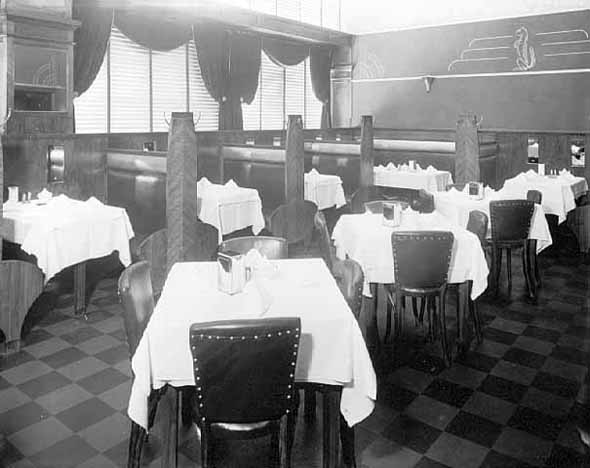
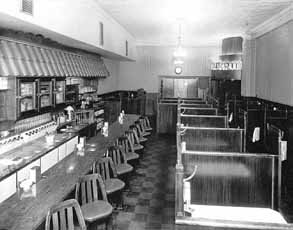
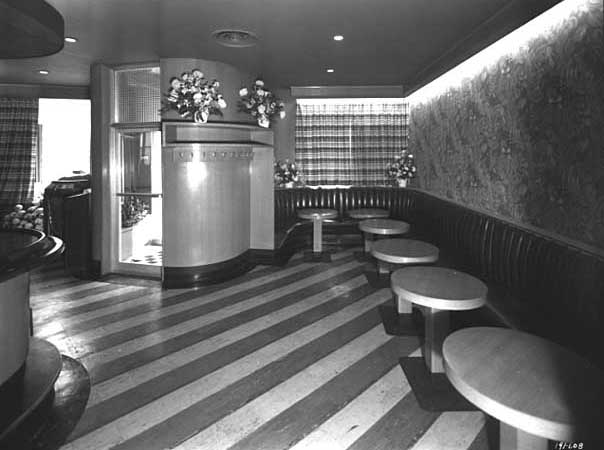
A representative from the contracting firm of Kraus-Anderson posted on Facebook that it did the remodeling work of this downtown landmark, a center of Minneapolis nightlife from the 1930s to the ’60s.
One reason for the Gopher’s centrality was its location: on the corner of 9th and Hennepin, it was in a theater district, the remnants of which can still be seen along Hennepin Avenue. Another thing about the Gopher Café was that it never closed. From 1935 to 1964, the Gopher was open 24 hours a day, seven days a week, with possible exceptions being made for the many renovations and expansions required to keep up with the its role as a mecca for nightclub and theater goers.
In 1950, Demos began to run ads disguised as comics. There was apparently a part of the restaurant called the Minnesota Room.
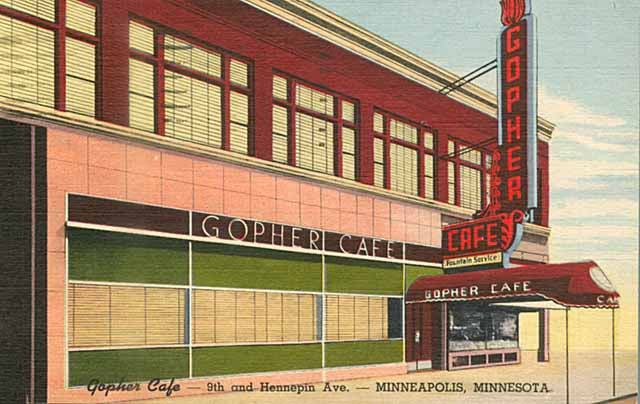
In August 1951, extensive remodeling was done to provide for a cocktail lounge. The permit card showed the cost to be $3,000.
In 1953, Kraus-Anderson did an astounding $10,000 in alterations to the building.
On May 2, 1958, the Gopher Cafe opened under new ownership, again by Greek immigrants. They were George Kosmas and his son-in-law, William Kordaris. Demos remained the owner of the building and remained in charge of the cocktail lounge. The Gopher was located outside the Liquor Patrol Limits.
The stock of the Gopher Cafe went up for sale on September 24, 1964.
1964
CASCADE 9
After two years of redesigning the restaurant, Jimmy Demos reopened it as the Cascade 9 on November 24, 1964.
Where magazine provides an extensive background into the beginnings of the Cascade 9.
One hardly expects to open a restaurant door on Hennepin Ave. and find the re-creation of a Colorado silver mine. But that’s precisely what lies inside the heavy wooden door of the Cascade 9, an intriguing and very atmospheric restaurant. The decor within simulates a series of caverns below the earth and the dim lights, each one made of heavy hand-cut crystal in a combination of greens and ambers, enhance the effect. It is no wonder that the atmosphere seems so authentic, since the research and planning which culminated in the opening of the restaurant took over two years.
The inspiration for the Cascade 9 was the Kelsay Mines, made famous in 1900 by a tremendous mineral find. Seemingly the last word in authenticity is the pickaxe from the Kelsay Mines which bedecks the front entrance at Cascade 9. Authentic memorabilia and souvenirs abound – stalactites, a waterfall, intricate stone work and a piano bar top made from rocks hand-picked on Xanthi, an island in the Mediterranean, and artfully placed so as to allow the passage of light. (January 20, 1968)
Don Morrison’s description of the place was more lighthearted. He called the decor “sort of Contemporary Mineshaft with Lourdes Grotto overtones.”
Set into a couple of the craggy walls are niches trickling water and sprouting ferns. Handrails conducting one between the multi-leveled rooms are made of massive iron chains having five-inch links. A series of such heavy chains hanging from the ceiling provides a screen between two of the rooms. (Minneapolis Star, November 23, 1964)
Rooms included:
An alcove at the Hennepin end contained the piano bar.
The Main cocktail lounge had a long bar, booths and tables.
To the rear is the rear was the room with the “flaming fountain, around the periphery of which are banquettes with Gothic-looking backrests that confer a vaguely ecclesiastical flavor.”
On the other side of the chain screen is the main dining room.
Two other large dining rooms were available for private parties.
So the name Cascade 9 came from the cascading waterfall, and the fact that it was on the corner of 9th Street. Uh huh!
THE MENU
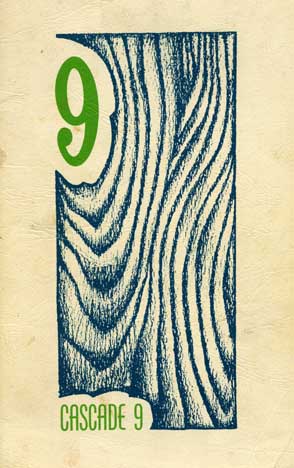
A menu generously loaned by Scott Smith has these additional bits of information:
The pickaxe was one of the 76 used during 13 continuous days of hand digging to rescue 43 of the estimated 100 trapped miners and prospectors at the Kelsay cave-in in 1903.
The rocks used in the walls are porous volcanic stone gathered from the 4,000-foot elevation of Mount Jacumba. Souvenirs of the rocks were made available to customers.
The Water and Fire Lounge had a waterfall in the corner which converted to a fireplace in the winter.
Drinks included the “Lamp Lighter,” with secret ingredients served in a candle-shaped glass and a two per person maximum.
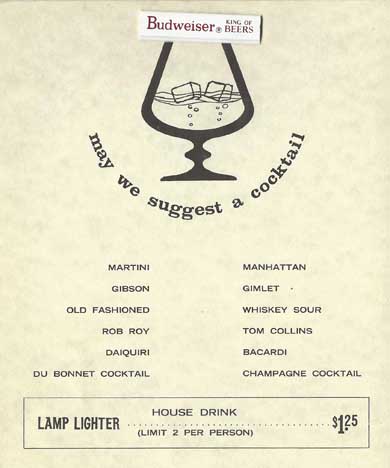
1965
January 1965 saw the first mention of entertainment, which was the piano lounge. The first ad did not mention who was playing the piano.
1966
Jazz musician Chuck Cochran was entertaining at the club in February 1966.
Select magazine began carrying the ad below in about September 1966, calling the place “An Adventure in Dining.” The same ad could be seen into January 1968.
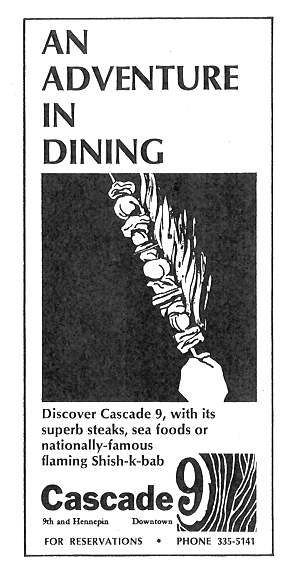
1967
Hugh Cardenas handled piano lounge duty, alternating with “Lorna,” in April and May 1967. The club was also offering a “dinner and a movie” special. Times must have been tough – by May 1967, Lorna was handling the piano bar by herself.
But in August 1967, Dick Clauson was brought on to provide organ music to double your pleasure in the piano bar.
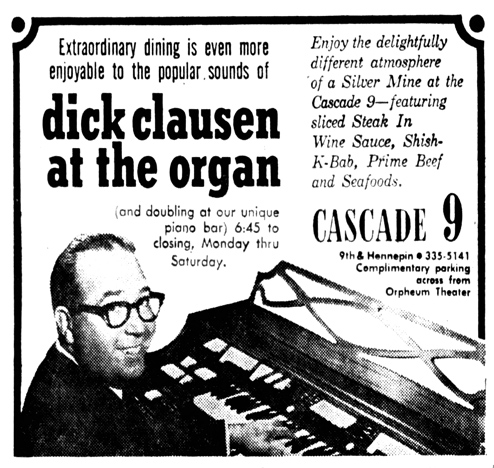
1968
On January 1, 1968, entertainment was provided by the Dixielanders, “playing music sweet and hot.” Members included Bob Benum on the drums, Doc Evans on clarinet, Harry Blons on trumpet, and Eddie Tolch on “piano and pipes.” (Where magazine, January 1968)
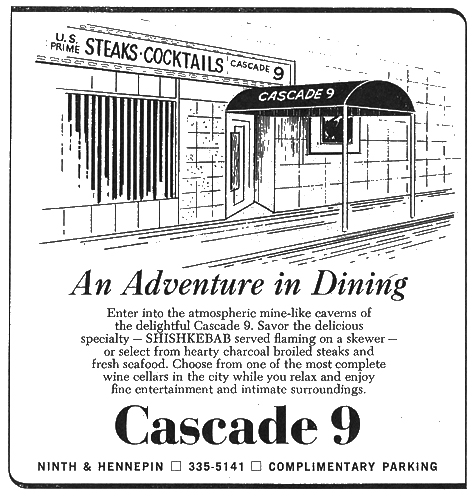
1969
Frank Cammarata entertained in January 1969.
Harry Blons’ Band opened an engagement in March 1969. Don Morrison reported that a new dance floor and bandstand had been installed. Blons continued through the rest of the year.
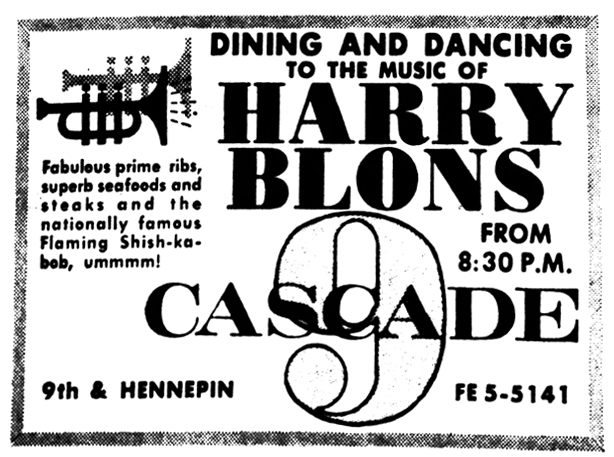
Jimmy Demos retired and sold the restaurant in 1969, according to his obituary.
1970
Harry Blons continued his engagement, playing Dixieland until about January.
On February 1, 1970, rock ‘n’ roll took over, with the XL-5.

The photo below is cropped from a larger picture that Mike Evangelist took standing in front of the M.L. Novak Jewler’s building at 930 Hennepin (later National Camera).
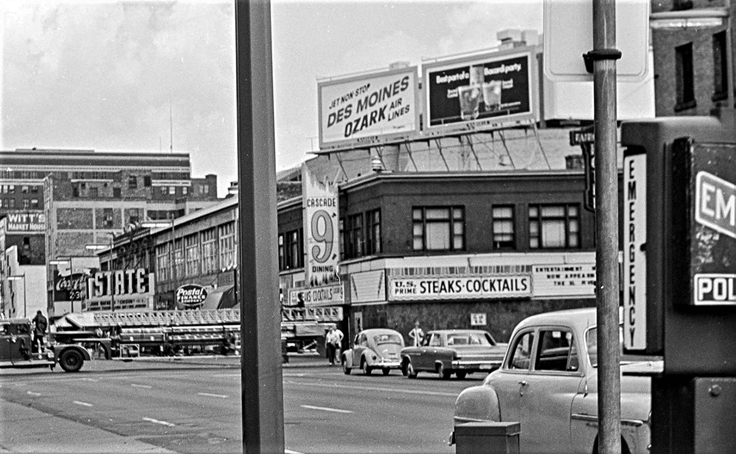
1971
The XL-5 finished their year-long run in March 1971.
In August 1971, Don Morrison noted that to accommodate the nighttime crowds, the place has almost doubled in size.
The Del Counts were the house band from 1971 to 1972.
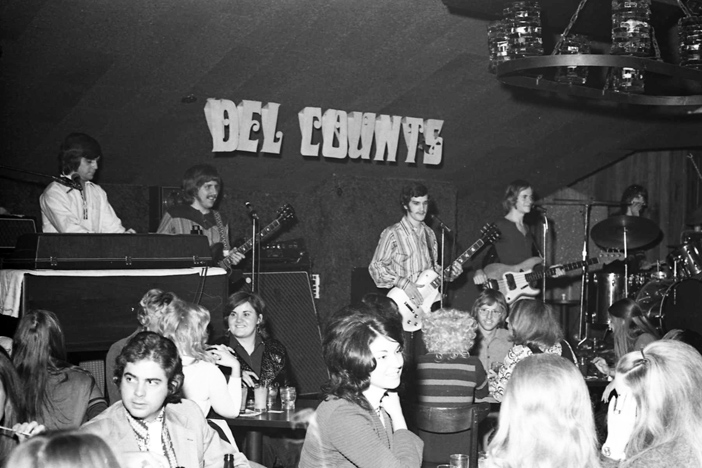
1972
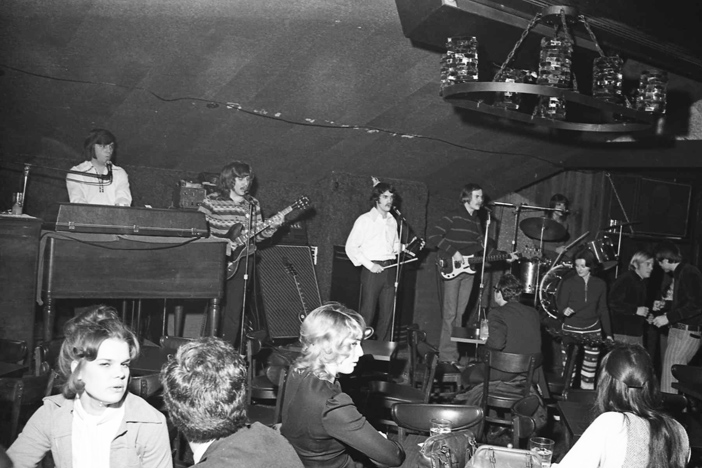
WAYNE COCHRAN
On March 23, 1972, Wayne Cochran and the 14-piece C.C. Riders appeared at 8 and 10 pm at the Cascade 9.
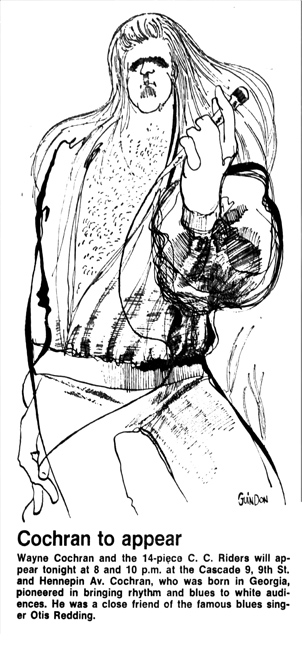
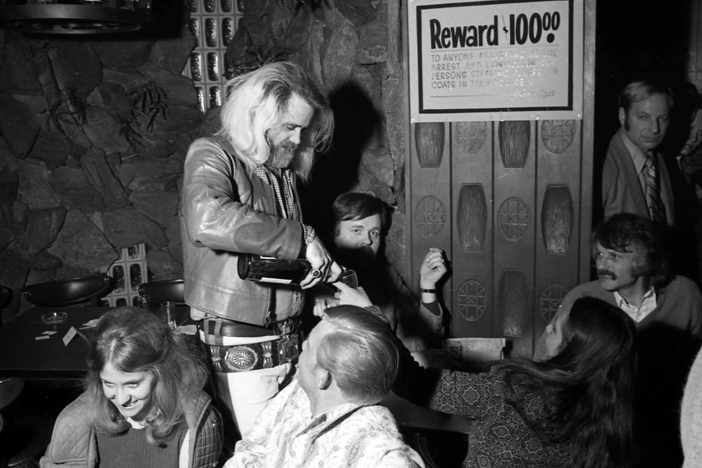
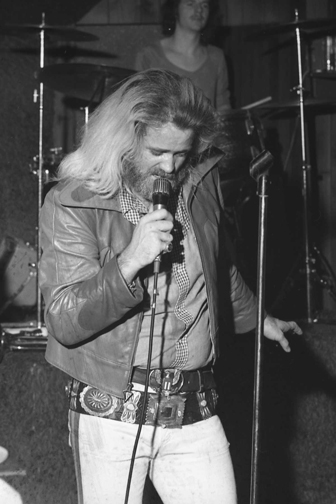
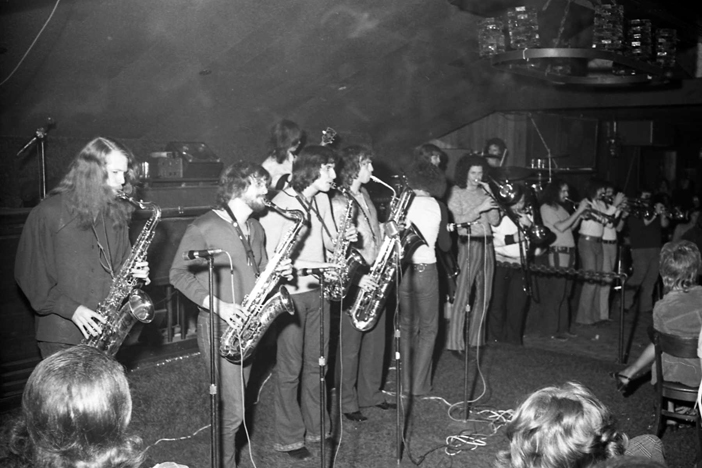
WATERFALL
In 1972, the Cascade 9 published its own monthly magazine, Waterfall. Volume I, Number II was dated July 1972, but there’s no telling how many issues there were. Principals were:
- Editor: John Edmund Sharpe
- Associate Editors: Aubrey Chapin, Rhonda Cupcake
- Art Director: Dane A. Krogman
- Photography: William Keenan, Len Scuvver
- Sports Editor: Larry Bader
- Publisher: Jerry Agar
Although he doesn’t seem to be credited, Mike Barich provided all of the photos of the Rolling Stones concert that was reviewed in the July 1972 issue.
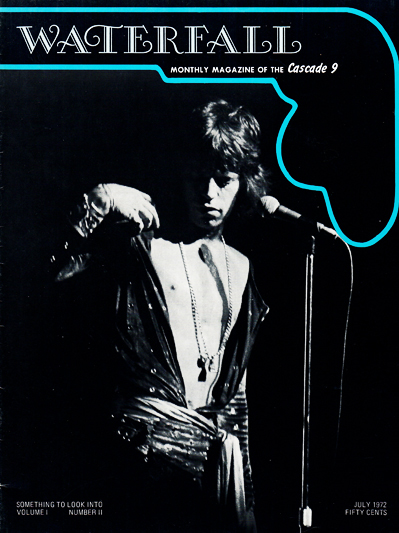
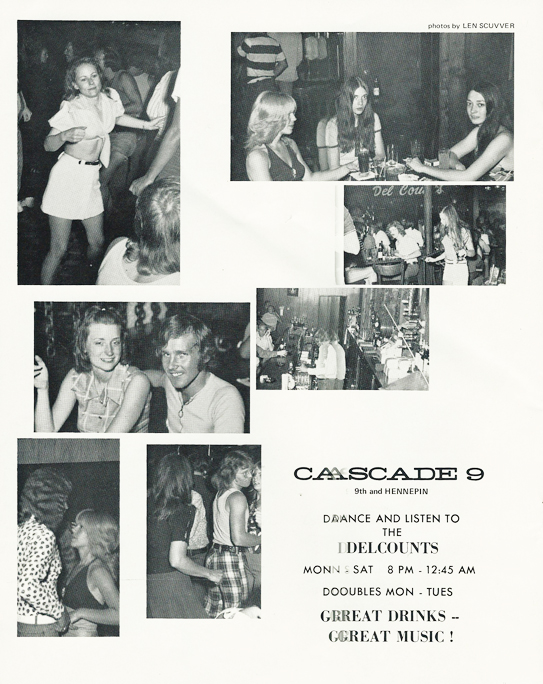
An article in the Minneapolis Tribune date November 27, 1972, named Jerry Agar as the owner of the Cascade 9.
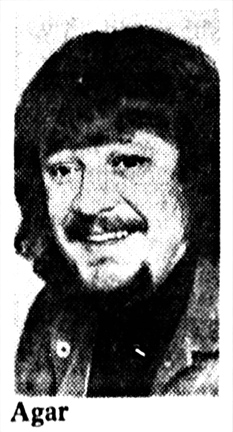
On December 9, 1972, the Tribune named LaRae Agar as the owner.
1973
In February 1973, owner LaRae Agar plead guilty to failure to withhold Social Security taxes for her employees at the Cascade 9 and another business. (Minneapolis Star, February 2, 1973)
June 1973: Teen King and the Princes
In September 1973, Jerry Agar was identified as the Manager.
1974
A notice was posted in the Minneapolis Star on May 5, 1974, that the Cascade 9 was “Opening Soon,” under the management of Pete Demos. Another gave the re-opening date as October 4, 1974.
1975
ZACHARIAH’S
On November 23, 1975, classifieds started for staff for a new club. From at least April to November 1976, the club was transformed into Zachariah’s, the home of Becky and the Sky Blue Water Boys. Johnny Hanson recalls that his band the Radio Rangers played there for three months, but was fired for demanding to be paid! The club went out of business in November 1977.
1977
EL-J’S
A blurb on November 18, 1977, describes El-J’s as the Former Zachariah’s, and says there’s a house band, but doesn’t say what it was called. The Grand Opening was held on December 13, 1977.
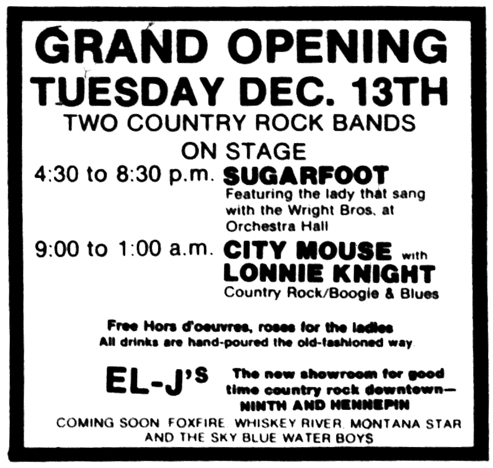
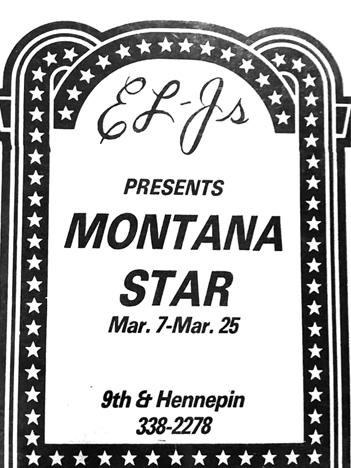
DUFF’S
When the original Duff’s burned down at its location at 21 So. 8th Street on December 24, 1978, owner Bob McNamara moved it to 829 Hennepin. He described the building as “a mess” and for six weeks he and 12 of his employees worked to paint and rehab the space in order to open it.
Duff’s opened here on March 1, 1979.
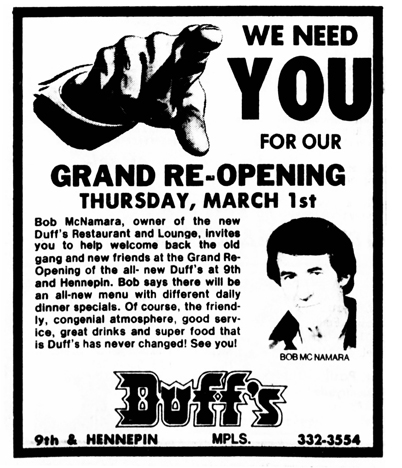
By all accounts, the new Duff’s was a man’s man’s Sports Bar in capital letters. It was also an Irish bar, with a Shamrock on the dance floor.
Owner Bob McNamara instituted several gimmicks, including “Topless Waiter Night,” a “Blitz Bus” shuttling U of M students to and from the bar, and Amateur Bartender and Waitress Night. (Minneapolis Star, November 23, 1979)
When it first opened, Monday was disco night, drawing students. Bands were brought in the rest of the week.
LOCAL ACTS
These are some of the bands I could find in calendars of events:
1979: Wind and Silver, First Flight, Areca, XL-5
1980: Areca, XL-5, Jules, Take Phive
1982: Areca
1984: Jomama, Recessive Traits, Don’t Ask, Super Cats, Showdogs, Go Great Guns, Criminals, Johnny Rey and the Reaction, Tete Noires, the Babysitters.
NATIONAL ACTS
Although I couldn’t find any ads for major concerts, Mike Qualley sent in these tickets showing that there were indeed some national performers:
Shawn Phillips performed at Duff’s on February 28, 1984.
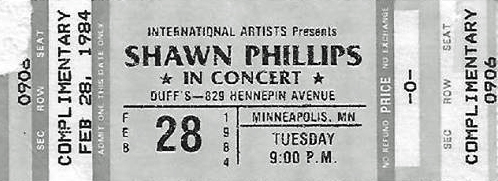
Roger McGuinn performed at Duff’s on April 2, 1984.

CLOUD 9
In May 1985, classified ads began to appear for staff for Cloud 9, “a progressive, alternative lifestyle bar.” Nothing else pops up until January 31, 1986, when the bar is called the Cloud 9 Express in an article about crime against gay people. Jim Tiggas is identified as the owner of the bar. (Minneapolis Tribune)
In September 1986, the Cloud 9 was in the paper when a German tourist was robbed by a man in drag that he met at the bar. The Tribune made sure to describe the man’s attire as a white, knee-length dress and pink boots. (September 10, 1986)
A notice on August 17, 1987, shows that Cloud 9, Inc. at 829 Hennepin Ave. had declared Chapter 11 bankruptcy on August 7, 1987. James B. Tiggas was the President.
The building was sold in December 1987 and 829 Hennepin is no more. It has been replaced by LaSalle Plaza, 825 Hennepin at 9th Street, built in 1991.


